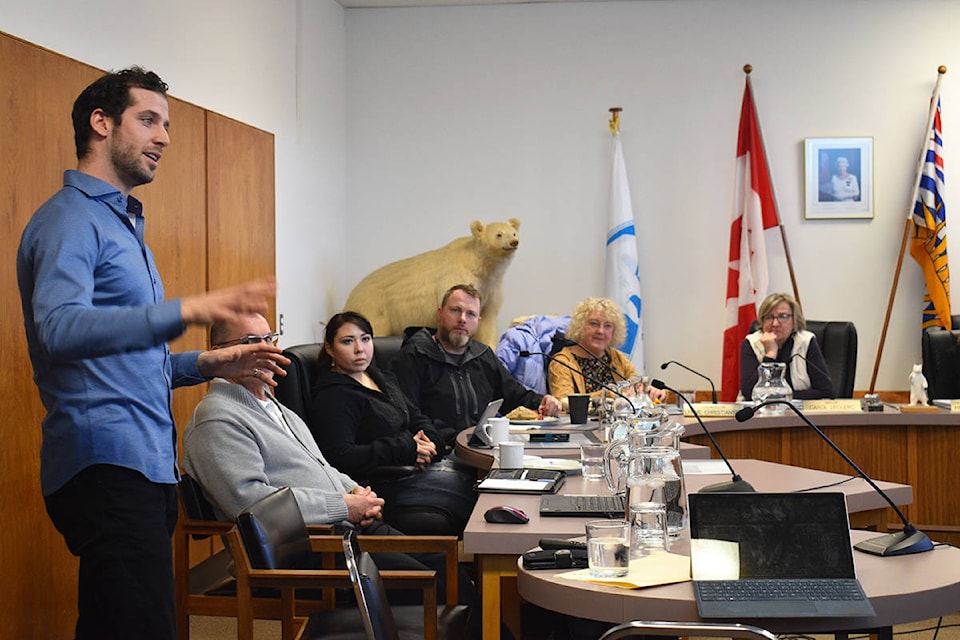With industrial development and an expected economic boom in the future, the City of Terrace will need to find revenue to patch up much of the city’s infrastructure as it degrades over time.
This follows a presentation from Urban Systems on the City of Terrace’s Asset Management Plan on Feb. 28. This new report was created using guidelines developed by the Union of British Columbia Municipalities (UBCM), creating an adaptable model to examine the sustainability of the city’s infrastructure over a 20-30 year time period.
It has two main purposes, first to help municipalities understand the current health of their assets using data to look over the long-term, and understand funding targets to meet those replacement needs before they reach the end of their lifecycle.
Cory Sivell from Urban Systems went over the report with city council and department heads. He says he’s worked with dozens of communities across Canada to develop similar plans, and has found most did not have enough data to make informed decisions about replacement needs over the long-term.
Updating this new model annually can help with that, he says.
“It helps ensure the services today can be provided in the future,” Sivell says. “Communities don’t want to be sitting here providing great water today and in 20 years, not be able to provide that because of lack of planning.”
READ MORE: City of Terrace reacts to $8 million provincial infrastructure grant
When it comes to Terrace, the city owns $292 million in assets, which the report breaks down into three capital funding areas.
General capital, which includes transportation, buildings, storm drainage and parks, make up a majority of the total, valued at $186.7 million. These assets are paid for using taxpayer money. Sewer and water systems, valued at $49.5 million and $54.6 million respectively are maintained with user fees.
Overall, the city’s assets have about 29 per cent remaining life, meaning 70 per cent of the assets’ longevity, or $204 million in financial value, has been used.
“Most communities in general are at 50 per cent, so they’re about halfway through their lifespan, so in general you may be pushing the lower end,” Sivell says.
Sewer systems were valued at 24 per cent remaining life, and underground water systems at 25 per cent.
General capital assets have 32 per cent left, with buildings seemingly worse off in comparison at 29 per cent.
Currently, 36 per cent of the city’s infrastructure is working past its life expectancy, with water systems at 45 per cent, sewer systems at 44 per cent, and 32 per cent for general capital.
Most of what taxpayers are paying for comes from transportation (roads, street lighting, sidewalks), valued at $94.5 million. Building maintenance costs the most at $55.8 million, with 53 per cent of the city’s buildings reaching $29.2 million for storm drainage, and $7.3 million for parks.
“If you spend more you have to tax more, but it typically means a higher level of service,” he says.
Though the city’s assets are around three-quarters of the way through its life expectancy, many of the infrastructure put in place in the 1960s is still functioning, says director of public works Rob Schibli.
Some assets, like the city’s wastewater system, are capable of operating into deficit, while others, like some city main roads, experience more wear and tear over time.
“I feel conservative…we’re not rampant with water breaks or road failures due to sewer breaks,” says Schibli.
READ MORE: City to see two per cent tax increase in 2019
Though the risk is higher when multiple assets remain in deficit for longer periods of time. With no changes to funding or operation, the overall deficit of these assets would grow from 36 per cent to 76 per cent in 30 years, Sivell says.
Over the coming weeks, city staff will be reviewing the data to decide if they want to improve or maintain current service levels, and where their replacement priorities are.
Chief financial officer Lori Greenlaw says there are no plans for a tax increase as staff are just beginning their review. She says this model is an “important component” for the city when applying to provincial and federal grant opportunities.
The city paid $15,000 to match a $15,000 UBCM grant to pay for the report in 2018.
brittany@terracestandard.com
Like us on Facebook and follow us on Twitter
